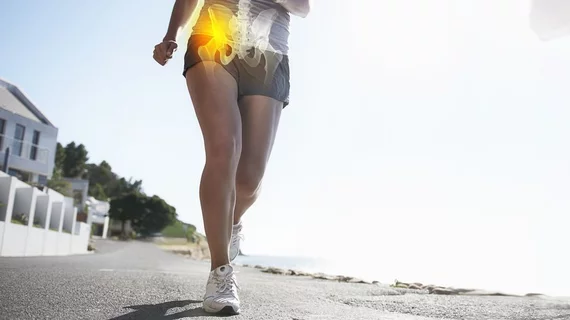AI model predicts hip fractures in a short-term timeframe
Utilizing digitally reconstructed radiographs generated from three-dimensional CT images of patients who suffered broken hips, a deep-learning model was able to predict the likelihood of a patient suffering a related fracture.
Researchers from South Korea said the artificial intelligence model can identify patients at high risk for fractures, so providers can implement appropriate prevention strategies to ensure broken hips heal properly and do not sustain further injuries. The findings were published in Radiology. [1]
“Patients who experience [a] fracture are also more likely to have subsequent fractures, with the risk being highest in the first few years after the initial fracture,” the authors led by Yisak Kim of Seoul National University Graduate School wrote. “However, studies aiming to identify patients most likely to experience subsequent fractures among those with a first fracture are scarce.”
Risk assessment guidelines do exist for predicting future hip fractures after a break, but they are unable to predict the risk for patients in the short term, working instead to “predict osteoporotic fractures in the long term, 5 or 10 years,” the authors noted.
Researchers examined 1,480 patients who underwent 3D CT scans after sustaining a broken hip between January 2004 and December 2020. Over an average follow-up period of 3.4 years, the team focused on primary outcomes, such as subsequent fractures in the spine, hip, humerus, or wrist, occurring at least three months after the initial injury.
The researchers trained their primary model using DenseNet convolutional neural network modules, referring to it as an ensemble model once it was trained on the digitally reconstructed X-rays.
Of the 1,480 individual patient records used for the study, 1,012 made up a training and validation set and 468 made up a test set. Both image sets included a small percentage of patients who experienced subsequent bone fractures after their CT scan. Utilizing the CT images, 2D X-rays were generated for the primary AI model of the study to analyze and assess the risk of future fractures. The results were compared to the actual patient outcomes.
To evaluate the ensemble model's effectiveness, the researchers measured its performance, juxtaposing those numbers against three alternative deep-learning models, each given variables based on sex, age, a patient’s weight, known arthritis, and personal habits, such as alcohol and tobacco use, that could impact the likelihood of poor bone health.
In any case, the ensemble model outperformed the others in predicting subsequent fractures, with a higher C index (0.73) in the test set compared to the range of C indexes (0.59–0.70) for the other models. Additionally, the researchers' primary AI achieved higher AUC values at 2-, 3-, and 5-year follow-ups (0.74, 0.74, and 0.73 respectively), compared to the other three image-based models. These differences were statistically significant (P < .001 to P < .05).
"In patients with recent hip fractures, the ensemble deep-learning model using digital reconstructed radiographs from hip CT showed good performance for predicting subsequent fractures in the short term," the researchers concluded.
The full study can be found at the link below.

